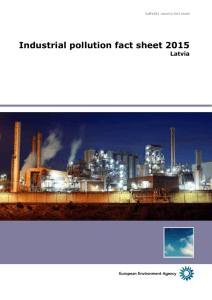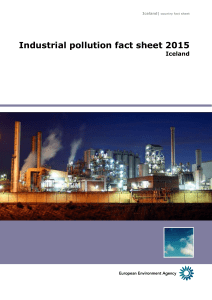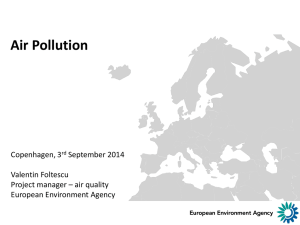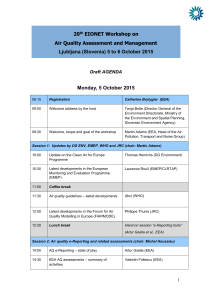Industry_Factsheet_SI - Eionet Forum
advertisement
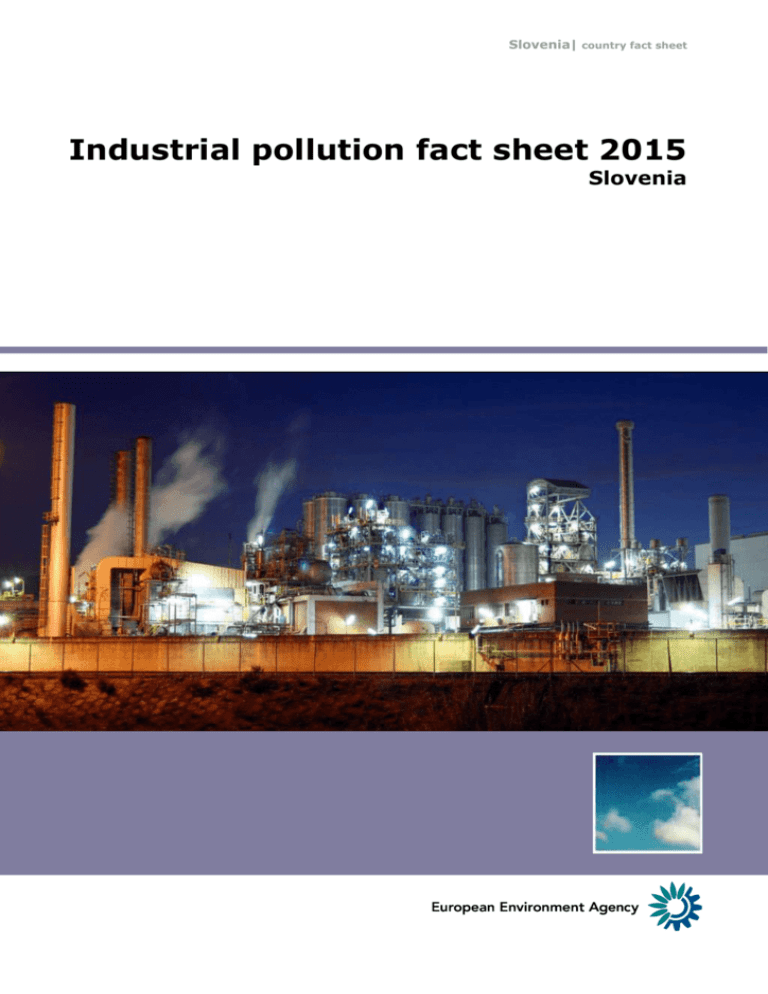
Slovenia| country fact sheet Industrial pollution fact sheet 2015 Slovenia Slovenia | country fact sheet Cover design: EEA Cover photo: Jorge Franganillo, Creative Commons Attribution 2.0 Generic (https://goo.gl/rqHYk6) Layout: EEA Acknowledgments This country fact sheet was prepared by the European Environment Agency in cooperation with the European Topic Centre for Air Pollution and Climate Change Mitigation. Content Introduction ………………………….……………………………………………………….………... Significance of industry ………………………………………………….………………………… 3 4 Significance of industry in terms of gross value added Significance of industry in terms of energy consumption Significance of industry in terms of water consumption Industrial emissions to air …………………………………………………………………….... 7 Significance of industry in terms of emissions to air Emission trend for key air pollutants and decoupling Industrial emissions to water …………………………………………………………………... 9 Significance of industry in terms of emissions to air Emission trend for key air pollutants and decoupling Industrial waste generation …………………………………………………………………….. 11 Significance of industry in terms of generation of waste Waste generation trend and decoupling References ………………………………………………………………………………………………. Industrial pollution country fact sheets 2015 14 2 Slovenia | country fact sheet Introduction Industry across the data sources While industry makes a significant contribution to the economic welfare and development of a country, pollution from industrial activities can also negatively impact people and the environment. These impacts (such as premature deaths, and damage to ecosystems) occur as a result of releases to air and water, through the disposal of waste, and through the demand for resources and energy. Industrial sources still contribute a substantial share of total pollution in Europe. Pollution from industry is subject to national, European, and international regulations and standards to limit releases, waste and resource use. Data sources These factsheets present a set of graphs and tables that show the significance of industrial pollution using data taken from several sources: Eurostat’s statistics on environment (ESTAT, 2015a) and energy (ESTAT, 2015b) and economy and finance statistics (ESTAT, 2015c) The European Pollutant Release and Transfer Register (E-PRTR) (EEA, 2015a) The European Environment Agency’s compilation of the national greenhouse gas inventories to be reported to the United Nations Framework Convention on Climate Change (EEA, 2015b) The European Environment Agency’s compilation of data on emissions of air pollutants to be submitted to the Convention on Long-range Transboundary Air Pollution (EEA, 2015c) This country fact sheet includes data available as of 31 December 2015. Definition of industry Due to the diverging legal definitions of industry in the different datasets, certain assumptions have been made to enable the presentation of industry in a consistent way (see the methodology document for more details). What is industry? Industry is the production of goods or services within an economy. The different data sources used in these fact sheets interpret this definition in slightly different ways. These fact sheets have attempted to cover comparable activities across the different databases that were used. In summary, the activities selected across the datasets are: energy industry, metal production, cement and lime production, mining and quarrying, chemical industry, manufacturing, waste industry (including water and sewage management), and distribution of electricity, gas, steam and air conditioning. The energy used for transport in the above industrial activities (except pipelines for the transmission of energy), and agricultural activities, are not included. Methodology The detailed methodology for the development of this country fact sheet is available at the Eionet forum1. Country coverage These country factsheets cover all European Environment Agency (EEA) member countries. The current EEA membership, comprising 33 countries and referred to as EEA33, include the 28 European Union Member States together with Iceland, Liechtenstein, Norway, Switzerland and Turkey. Therefore, the graphs and tables presented in this document offer data of Slovenia and the rest of the EEA member countries. However, in some cases data were not available for one or more countries. Below each table and figure, the source and the countries for which data were missing are included. 1 http://forum.eionet.europa.eu/nrc-industrial-pollution/library/consultations Industrial pollution country fact sheets 2015 3 Slovenia | country fact sheet Significance of industry SIGNIFICANCE OF INDUSTRY WITHIN THE ECONOMY IN TERMS OF GROSS VALUE ADDED This section shows the significance of industry in the context of the economy. The parameter used is gross value added (GVA), which captures the value in terms of goods and services provided by an economic activity. Figure 1. GVA of industry as % of EEA33 economy, and within Slovenia, 2013 Source: ESTATc, 2015. Data gap-filled according to methodology Figure 2. Evolution of GVA of industry in Slovenia, €billion, 2000-2013 Source: ESTATc, 2015. Data gap-filled according to methodology GVA (B€) 2006 2007 2008 Manufacturing 6.2 6.7 6.9 Electricity, gas (…) 0.7 0.7 0.7 Mining & qarrying 0.1 0.1 0.1 Waste management 0.3 0.3 0.4 Total industry 7.3 7.9 8.2 2009 5.8 0.8 0.1 0.3 7.0 2010 6.3 0.8 0.1 0.3 7.6 2011 6.2 0.8 0.1 0.3 7.5 2012 6.2 0.9 0.1 0.3 7.5 SIGNIFICANCE OF INDUSTRY IN TERMS OF ENERGY CONSUMPTION Industrial pollution country fact sheets 2015 4 2013 6.7 0.9 0.1 0.4 8.2 Slovenia | country fact sheet This section shows the significance of industry as an energy consumer. The parameter used is final energy consumption, which accounts for the energy supplied to the consumer (i.e. industry) for all energy used involved to run the processes in the industrial activities considered in this fact sheet. Figure 3. Energy consumption of industry as % of EEA33 energy consumption, and within Slovenia, 2013 Source: ESTAT, 2015b. No data for LI. Data gap-filled according to methodology Figure 4. Evolution of energy consumption of industry, broken down by sectors, within Slovenia, Petajoules (PJ), 1990-2013 Source: ESTAT, 2015b. Data gap-filled according to methodology Energy consumption 2006 2007 2008 2009 (PJ) Chemical industry 7.2 7.7 6.7 6.6 Manufacturing 28.9 26.5 24.4 21.1 Metal industry 14.5 14.2 12.5 9.3 Mining & quarrying 0.8 0.6 0.6 0.7 Other industry 16.2 16.0 15.3 11.3 Total industry 67.5 65.0 59.5 49.1 2010 7.1 22.0 10.1 0.7 11.9 51.8 2011 6.6 20.4 11.8 0.6 11.1 50.4 2012 6.2 19.6 12.5 0.6 10.0 49.0 SIGNIFICANCE OF INDUSTRY IN TERMS OF WATER USAGE Industrial pollution country fact sheets 2015 5 2013 6.3 19.2 12.5 0.7 10.4 49.0 Slovenia | country fact sheet This section shows the significance of industry as a water consumer. The parameter used is water usage, which accounts for the water supplied to the consumer (i.e. industry) for all water uses needed to run the processes in the industrial activities considered in this fact sheet. Figure 5. Water usage by industry as % of EEA33 water usage, and within Slovenia, 2013 Source: ESTAT, 2015a. No data for LI. Data gap-filled according to methodology Figure 6. Evolution of industrial water usage within Slovenia, million cubic meters (Mm3), 1990-2013 Source: ESTATa, 2015. No data for LI. Data gap-filled according to methodology Water consumption 2006 2007 2008 2009 2010 (Mm3) Manufacturing 13.00 12.00 11.00 10.00 9.00 Mining & quarrying 0.38 0.35 0.33 0.30 0.28 Electricity, gas (…) 1.00 1.13 0.93 0.60 0.80 Total industry 14.38 13.48 12.26 10.90 10.08 Industrial pollution country fact sheets 2015 2011 9.00 0.25 0.53 9.79 2012 8.48 0.23 0.26 8.97 6 2013 10.74 0.19 0.24 11.17 Slovenia | country fact sheet Industrial emissions to air SIGNIFICANCE OF INDUSTRY IN TERMS OF EMISSIONS TO AIR Air pollution harms human health and the environment. In Europe, emissions of many air pollutants have decreased substantially in recent decades, resulting in improved air quality across the region. However, air pollutant concentrations are still high, and air quality problems persist. The selected pollutants for which data are provided in this section are those that cause significant pressure on the environment and human health. Nitrogen oxides (NOx), sulphur oxides (SOx) and ammonia (NH3) cause acidification and eutrophication. Non-methane volatile organic compounds (NMVOC) and particulate matter (PM10) play a key role in air quality, especially in the so-called smog. Finally, the release of heavy metals lead to their accumulation in the food chain, an issue of concern given their toxicity. The heavy metals considered are arsenic (As), chromium (Cr), lead (Pb), and mercury (Hg). Figure 7. Industrial air emissions as % of total country pollution, by sector origins, 2013 – Slovenia For each pollutant, the coloured sections of the bars represent the contribution of the different industrial sectors. The grey areas refer to the contribution of the rest of the human activities (other than industry). The quantities, expressed in percentages, refer to the country’s total air emissions of each pollutant. The smaller the grey area the bigger the significance of industrial releases for the concerned pollutant. In the CLRTAP, NOx is reported as nitric oxide and nitrogen dioxide, expressed as nitrogen dioxide (NO2), and SOx covers all sulphur compounds expressed as sulphur dioxide (SO2) (including sulphur trioxide, sulphuric acid, and reduced sulphur compounds, such as hydrogem sulphide, mercaptans and dimethul sulphides, etc.) Source: EEA, 2015c Emissions (tonnes) A s - Cr - - Energy industry - - 0.08 0.00 Food & drink industry Iron & steel manufacturing Mining & quarrying - - 0.04 - - Non-ferrous production - - 0.21 - Cement and production Chemical industry lime metal Hg - 0.06 - Industrial pollution country fact sheets 2015 NH3 NMVOC 91.33 314.83 - 2 406.49 9 067.17 537.35 31.12 3 101.60 11.54 NOx (as NO2) 571.77 Pb 0.16 334.64 SOx (as SO2) 919.41 - 35.12 91.66 9 170.69 266.39 - 1.72 - 9 802.71 1.22 128.08 11.63 141.57 7.47 104.59 819.36 13 062.78 PM10 2.20 7 160.39 - Slovenia | country fact sheet Other manufacturing - - 0.00 - Pulp, paper, & wood (…) Waste industry Non industry - - 0.00 - 11.43 15 473.25 1 653.01 140.34 131.18 15 157.22 687.56 0.20 298.26 63.24 11.90 17 004.80 0.02 4.15 129.34 0.09 1 958.63 9.79 49.98 EMISSIONS TRENDS FOR KEY AIR POLLUTANTS Emissions and economic growth trends are often coupled. EU policy aims, among other objectives, at decoupling economic growth from emissions, and driving down emission trends, whilst allowing economies to continue to grow. Decoupling of industrial emissions from industry GVA growth can be absolute (emissions decrease where GVA increases) or relative (emissions increase at a slower rate than GVA). Selected pollutants emissions, indexed to 2007, are presented together with GVA (also indexed to 2007) to show the coupling or decoupling of pollutant releases with economic growth. Figure 8. Industrial air pollution versus the economy (non heavy metals), Slovenia, 2007-2013 Source: EEA, 2015a Emissions (tonnes) 2007 2008 2009 2010 2011 NH3 89 109 103 93 74 NMVOC 2 935 2 557 1 677 1 469 1 277 NOx/NO2 14 625 14 846 13 808 12 607 11 836 PM10 2 033 378 260 213 336 SOx/SO2 9 363 8 064 7 141 6 664 7 472 Figure 9. Industrial air pollution versus the economy (heavy metals), Slovenia, 2007-2013 2012 123 1 278 10 691 368 6 838 Source: EEA, 2015a Industrial pollution country fact sheets 2015 8 2013 84 999 10 158 216 6 407 Slovenia | country fact sheet Emissions (kg) As Cr Hg 2007 Pb 98 286 38 2008 29 224 20 2009 29 355 57 2010 23 566 45 2011 54 403 106 2012 38 334 89 1 121 916 - - - 436 2013 37 282 103 675 Industrial emissions to water SIGNIFICANCE OF INDUSTRY IN TERMS OF EMISSIONS TO WATER Industrial activities are an important source of water pollution. Industry realeases pollutants that can be harmful to people and the environment. In this section, data are provided for the heavy metals arsenic (As), cadmium (Cd), chromium (Cr), copper (Cu), mercury (Hg), nickel (Ni), lead (Pb), zinc (Zn); the nutrients nitrogen (Tot-N) and phosphorus (Tot-P); and the total organic carbon content (TOC). For each pollutant, the coloured sections of the bars represent the contribution of the different industrial sectors. The sector’s contributions, expressed in percentages, refer to the country’s total industrial water emissions of each pollutant as reported to the European Pollutant Release and Transfer Register (E-PRTR). For water releases, there are no complete inventories of emissions covering all human activities. That is why the data source for this medium is the E-PRTR. This dataset only covers releases above a certain threshold for selected industrial activities. Therefore, this graph captures a subset of the industrial reality. In the E-PRTR heavy metals include compounds. Figure 10. Industrial water emissions as % of total country E-PRTR pollution, by sector origins, 2013 – Slovenia Source: EEA, 2015a Emissions (tonnes) Electricity, (…) gas, Manufacturing As steam Cd Cr - - - - - - - - TotN - - - - 0.11 - - 0.03 30.1.00 - Industrial pollution country fact sheets 2015 Cu Hg Ni Pb TOC 9 Tot-P Zn - - - 0.39 Slovenia | country fact sheet Mining & quarrying - - - - - - - - - - - Waste management (…) - - - - - - - - - - - Industrial pollution country fact sheets 2015 10 Slovenia | country fact sheet EMISSIONS TRENDS FOR KEY WATER POLLUTANTS This section presents indexed data on emissions (annual loads) and growth (GVA) to show the possible decoupling of economy and environment pressures. An explanation of this concept is in the same section for air pollutants (page 8). Figure 11. Industrial water pollution versus the economy, Slovenia, 2007-2013 Source: EEA, 2015a Note: As heavy metals in water represent a comparable pressure to the environment, they can be aggregated by their relative toxicity. The methodology document includes details on this aggregation. The heavy metal releases are weighted by factors corresponding to the reciprocal Predicted No Effect Concentrations (PNEC) values (1/PNEC) (OSPAR, 2014) for each pollutant and set equivalent to one of the metals - here Mercury has been chosen. Emissions (tonnes) 2007 2008 2009 2010 2011 2012 Heavy Metals (Hg See individual pollutants in table below. specific) Total Organic Carbon 325 386 275 344 286 192 (TOC) Tot-N 70 Tot-P Figure 12. Industrial water pollution versus the economy (Heavy Metals), Slovenia, 2007-2013 Source: EEA, 2015a Emissions (kg) As Cd Cr Cu Hg Ni Pb 2007 2008 56 105 2 50 106 Industrial pollution country fact sheets 2015 2009 79 1 60 86 2010 56 41 163 53 - 2011 108 30 2012 2013 301 - 2013 67 30 11 110 30 Slovenia | country fact sheet Zn 1 502 Industrial pollution country fact sheets 2015 1 922 386 899 665 302 12 389 Slovenia | country fact sheet Waste generation SIGNIFICANCE OF INDUSTRY IN TERMS OF GENERATION OF WASTE The waste produced by industrial activities consists of sources such as chemical solvents, paints, paper products, industrial by-products, and metals. In the following analysis, data concerning industrial waste are grouped into three types: hazardous waste, non-hazardous waste, and waste from mining and quarrying. Hazardous waste can pose a risk to health or the environment if not managed and disposed correctly. The properties of waste which render it hazardous are defined in Annex III to the Waste Directive (EC, 2008), and include being explosive, flammable, toxic, and carcinogenic. Waste from mining and quarrying is presented in its own group, due to the different nature and large volumes of this type of waste. Mining and quarrying waste is waste resulting from the prospecting, extraction, treatment and storage of mineral resources and the working of quarries. This category of waste is also addressed by a separate Directive on the management of waste (EC, 2006). The following figures on waste generation, show 1) waste intensity (waste (tonnes)/GVA (€millions)), 2) the share of waste generation by the different activities out of the EEA33 total waste generation and 3) the share of country waste generation totals. Waste intensity quantifies the relationship between the waste generation and economic output. The larger the number, the more waste-generating that country is compared to the GVA the sector produces. Figure 13. Industrial non hazardous waste generation as % of total EEA waste, with waste intensity, 2012 Source: ESTAT, 2015a. No data for CH. Industrial pollution country fact sheets 2015 13 Slovenia | country fact sheet Figure 14. Industrial hazardous waste generation as % of total EEA waste, with waste intensity, 2012 Source: ESTAT, 2015a. No data for CH. Figure 15. Mining and quarrying waste generation as % of total EEA waste, with waste intensity, 2012 Source: ESTAT, 2015a. No data for CH. Industrial pollution country fact sheets 2015 14 Slovenia | country fact sheet WASTE GENERATION TREND This section presents indexed data on waste generation broken down by sectors and growth (GVA) to show the possible coupling or decoupling of the economy and environmental pressures. An explanation of the concept is available in the same section for air pollutants (page 8 of this factsheet). In this case, the data was indexed to 2004 levels. Figure 16. Decoupling of industrial non-hazardous waste, 2004-2012 Source: ESTAT, 2015a. Waste (tonnes) Electricity, gas (…) Manufacturing Mining & quarrying Waste management Figure 17. Decoupling of industrial Source: ESTAT, 2015a. Waste (tonnes) Electricity, gas (…) Manufacturing Mining & quarrying Waste management 2004 2006 2008 2010 1 545 006 497 798 352 952 1 384 1 894 615 2 313 119 1 657 493 1 442 128 670 376 867 54 333 11 53 826 44 999 116 491 93 hazardous waste, 2004-2012 (latest years available) 2004 739 65 459 32 614 Industrial pollution country fact sheets 2015 2006 772 72 160 63 2 848 2008 688 77 285 186 9 199 2012 1 067 1 277 14 208 082 418 715 971 2010 3 998 71 694 82 4 335 420 190 410 274 2012 1 654 67 809 38 29 113 15 Slovenia | country fact sheet References EC 2006. Directive 2006/21/EC of the European Parliament and of the Council of 15 March 2006 on the management of waste from extractive industries and amending Directive 2004/35/EC (http://eur-lex.europa.eu/legal-content/EN/TXT/?uri=CELEX:32006L0021) accessed 24 November 2015 EC 2008. Directive 2008/98/EC of the European Parliament and of the Council of 19 November 2008 on waste and repealing certain Directives. (http://eurlex.europa.eu/LexUriServ/LexUriServ.do?uri=OJ:L:2008:312:0003:0030:en:PDF) accessed 24 November 2015 EEA 2015a. European Pollutant Release and Transfer Register (E-PRTR) v7.0 Dataset. (http://www.eea.europa.eu/data-and-maps/data/member-states-reporting-art-7-under-theeuropean-pollutant-release-and-transfer-register-e-prtr-regulation-10) accessed 24 November 2015 EEA 2015b. European Environment Agency’s compilation of the national greenhouse gas inventories to be reported to the United Nations Framework Convention on Climate Change (UNFCCC) Dataset. (http://www.eea.europa.eu/data-and-maps/data/national-emissionsreported-to-the-unfccc-and-to-the-eu-greenhouse-gas-monitoring-mechanism-9) accessed 24 November 2015 EEA 2015c. European Environment Agency’s compilation of data on emissions of air pollutants to be submitted to the Convention on Long-range Transboundary Air Pollution (CLRTAP) Dataset. (http://www.eea.europa.eu/data-and-maps/data/national-emissionsreported-to-the-convention-on-long-range-transboundary-air-pollution-lrtap-convention-9) accessed 24 November 2015 ESTAT 2015a. Eurostat’s statistics (http://ec.europa.eu/eurostat/data/database tables env_wat_cat env_wat_abs and env_wasgt) accessed 24 November 2015 on environment env_wat_ind and ESTAT 2015b. Eurostat’s statistics on energy (http://ec.europa.eu/eurostat/data/database table nrg_110a) accessed 24 November 2015 ESTAT 2015c. Eurostat’s statistics on economy and finance statistics (http://ec.europa.eu/eurostat/data/database table nama_nace64_k) accessed 24 November 2015 OSPAR 2014. Establishment of a list of Predicted No Effect Concentrations (PNECs) for naturally occurring substances in produced water (OSPAR Agreement 2014-05) (https://www.gov.uk/government/uploads/system/uploads/attachment_data/file/361476/OSP AR_RBA_Predicted_No_Effect_Concentrations__PNECs__Background_Document.pdf) accessed 24 November 2015 Industrial pollution country fact sheets 2015 16

